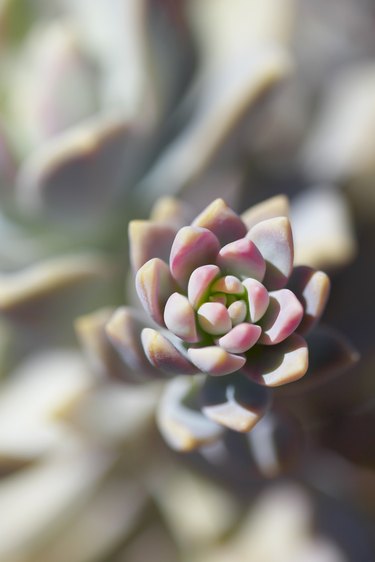
Succulents are fleshy plants that can withstand long periods of drought because they store water in their leaves, which are protected from evaporation by a thick, waxy cuticle. They use the stored water very sparingly and have extensive fibrous root systems that have tremendous sucking capability. Succulents are low-maintenance plants that have few disease problems, except for when they are grown under poor cultivation practices.
Sooty Mold
Video of the Day
Black sooty mold that grows on the leaves and stems of succulents is indicative of an insect problem. That is because this easily removable substance grows on the sweet, sticky substance that is excreted by sap-sucking insects. Mites, aphids, mealy bugs and scale all excrete the sticky substance known as honeydew. Although sooty mold can be wiped off easily with a wet cloth or rubbing alcohol, if left unchecked it can block the succulent from receiving sufficient light, thereby prohibiting the photosynthesis process. The leaves produce fewer nutrients and may turn yellow. Wipe the black mold off and control the insects using an insecticidal soap or horticultural oil. Insects are attracted to weak plants, so ensure the succulent is grown using proper growing methods.
Video of the Day
Anthracnose
A large group of fungi from the Colletotrichum family, anthracnose most frequently occurs on succulent plants that are grown in insufficient light, overwatered or watered using overhead irrigation. Identify the succulent fungal disease by the brown lesions on the leaves or crown. There may be an active pink, red or orange spore pad in the lesions. These spores disperse by wind and splashing water. Remove infected plant areas, avoid overhead watering and prevent further spreading by applying a Bordeaux mix, a mixture of hydrated lime, sulfur and copper.
Stem Rot
Overwatering of succulents mixed with cool weather, or planting the succulent in the soil too deeply, provides a prime breeding ground for stem rot-causing fungi. Dark lesions that enlarge in size and deepen in darkness occur at the base of the stem and spread upwards. The succulent's leaves shrivel, and the succulent may die. Remove infected plant areas, improve soil drainage and avoid overwatering the succulent. During the growing season, wait until the soil is completely dry before watering. Don't allow the succulent plant to sit in a tray of water.
Cotton Root Rot
Cotton root rot can affect several types of succulents and is most prevalent in areas with hot summers, soils with a pH range of 7.0 to 8.5 and temperatures above 82 degrees Fahrenheit. Succulents infected with cotton root rot usually die, and once the succulent plant is pulled up, brown fungal strands are attached to the roots. There is no known cure for this succulent fungal disease, which can persist in the soil for several years after the plant's removal.